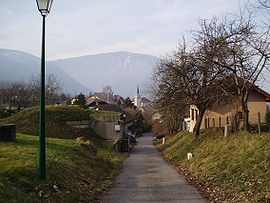Vulbens: Difference between revisions
m Disambiguating links to Genevois (link changed to Genevois (province)) using DisamAssist. |
m →History: clean up, replaced: Bourbon Restoration → Bourbon Restoration |
||
| Line 34: | Line 34: | ||
The area of the Knights Templar later became the property of the hospital and then was transformed into a farm to the Revolution. Today, riding stables, the only visible remnant of his past is a portal which is engraved on the cross of Malta on the keystone. |
The area of the Knights Templar later became the property of the hospital and then was transformed into a farm to the Revolution. Today, riding stables, the only visible remnant of his past is a portal which is engraved on the cross of Malta on the keystone. |
||
During the [[French Revolution]], the Savoy region was conquered by France and Vulbens became attached to the ''département'' of [[Léman (department)|Léman]], of which capital was [[Geneva]]. After the [[Bourbon Restoration]] in 1815, it was returned to the [[Kingdom of Sardinia]] (heir of the [[Duchy of Savoy]]). When Savoy was annexed to France in 1860, it became part of the new ''département'' of [[Haute-Savoie]]. |
During the [[French Revolution]], the Savoy region was conquered by France and Vulbens became attached to the ''département'' of [[Léman (department)|Léman]], of which capital was [[Geneva]]. After the [[Bourbon Restoration in France|Bourbon Restoration]] in 1815, it was returned to the [[Kingdom of Sardinia]] (heir of the [[Duchy of Savoy]]). When Savoy was annexed to France in 1860, it became part of the new ''département'' of [[Haute-Savoie]]. |
||
==Population== |
==Population== |
||
Revision as of 10:12, 16 February 2021
Vulbens | |
|---|---|
 A view within Vulbens | |
| Coordinates: 46°06′08″N 5°55′52″E / 46.1022°N 5.9311°E | |
| Country | France |
| Region | Auvergne-Rhône-Alpes |
| Department | Haute-Savoie |
| Arrondissement | Saint-Julien-en-Genevois |
| Canton | Saint-Julien-en-Genevois |
| Intercommunality | Genevois |
| Government | |
| • Mayor (2020-2026) | Benoit Florent |
Area 1 | 12.53 km2 (4.84 sq mi) |
| Population (2022)[1] | 1,698 |
| • Density | 140/km2 (350/sq mi) |
| Time zone | UTC+01:00 (CET) |
| • Summer (DST) | UTC+02:00 (CEST) |
| INSEE/Postal code | 74314 /74520 |
| Elevation | 327–920 m (1,073–3,018 ft) |
| Website | http://www.vulbens.fr |
| 1 French Land Register data, which excludes lakes, ponds, glaciers > 1 km2 (0.386 sq mi or 247 acres) and river estuaries. | |
Vulbens is a commune in the Haute-Savoie department in the Auvergne-Rhône-Alpes region in south-eastern France.
Vulbens is located 20 kilometres southwest of Geneva, on the hills of the Vuache. Vulbens has a border with Switzerland, the commune of Chancy. Other neighbouring municipalities are Chevrier, Pougny, Valleiry, Viry and Dingy-en-Vuache.
History
Vulbens was part of the former province Genevois of the Duchy of Savoy.
Templars moved in 1196 to Vulbens, near the place called "Port of the Isles" (near Collogny) and controlled the passage of the Rhone by people crossing by ferry Traille. The area of the Knights Templar later became the property of the hospital and then was transformed into a farm to the Revolution. Today, riding stables, the only visible remnant of his past is a portal which is engraved on the cross of Malta on the keystone.
During the French Revolution, the Savoy region was conquered by France and Vulbens became attached to the département of Léman, of which capital was Geneva. After the Bourbon Restoration in 1815, it was returned to the Kingdom of Sardinia (heir of the Duchy of Savoy). When Savoy was annexed to France in 1860, it became part of the new département of Haute-Savoie.
Population
| Year | Pop. | ±% |
|---|---|---|
| 2005 | 845 | — |
| 2006 | 839 | −0.7% |
| 2007 | 835 | −0.5% |
| 2008 | 895 | +7.2% |
| 2009 | 930 | +3.9% |
| 2010 | 966 | +3.9% |
| 2011 | 997 | +3.2% |
| 2012 | 1,161 | +16.4% |
| 2013 | 1,275 | +9.8% |
| 2014 | 1,398 | +9.6% |
| 2015 | 1,521 | +8.8% |
| 2016 | 1,541 | +1.3% |
The inhabitants of Vulbens are called Vulbanaises and Vulbanais.
See also
References
- ^ "Populations de référence 2022" (in French). The National Institute of Statistics and Economic Studies. 19 December 2024.




